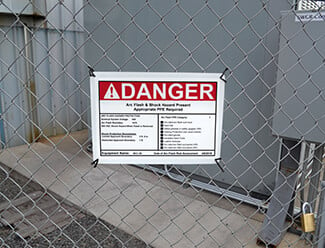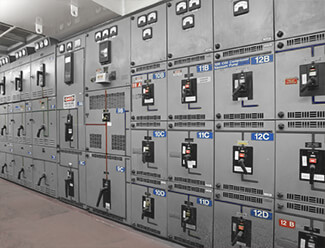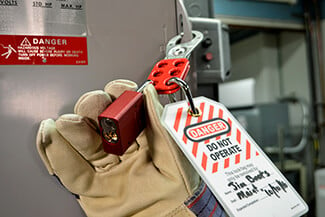4 Electrical Hazards of the Power Industry: OSHA Signs for Safety
03
February,
2023
5 MINUTE READ

OSHA Signs to Increase Safety in the Electric Power Industry
In the high-risk environment of the electric power industry, electrical hazards are always present, so safety is crucial. Understanding and mitigating hazards is important to protecting workers and preventing accidents. In this article, we explore four significant hazards prevalent in the electric power sector and highlight the importance of OSHA signs in enhancing safety protocols. These signs serve as vital visual cues, alerting workers to potential dangers and guiding them towards safe practices. By recognizing and adhering to OSHA signage, organizations can proactively safeguard their workforce and promote a culture of safety within the industry.
Looking at the Electric Power Industry Numbers
Electric utility hazards can be as diverse as the sources from which they derive their energy, but whether in renewable or legacy fossil fuel facilities, the OSHA shares that the following four issues cause the most injuries and fatalities per year.
-
Electrocution
-
Falls
-
Confined Spaces (engulfment)
-
Fires and Explosions
Occupations that frequently utilize electricity are at risk of experiencing an electrical incident. According to the Bureau of Labor and Statistics, in 2020:
- Three in five injuries caused by direct exposure to electricity
- 126 deaths
- 2,380 non-life threatening injuries
The following power plant safety tips stand in direct opposition to the four primary electrical hazards workers are faced with and offer easy-to-implement solutions, , that can boost productivity and limit risk.
Tip 1: Using OSHA Signs for the Hierarchy of Controls To Reduce Risk
 In the 2018 edition of NFPA 70E, the National Fire Prevention Agency clarifies the Hierarchy of Controls found in previous editions. While not required by law, the 70E standard is considered the model for OSHA safe work practices, which may include the use of OSHA signs.
In the 2018 edition of NFPA 70E, the National Fire Prevention Agency clarifies the Hierarchy of Controls found in previous editions. While not required by law, the 70E standard is considered the model for OSHA safe work practices, which may include the use of OSHA signs.
The controls are:
-
Elimination - moving a power control station from a raised platform to ground level, ensuring that the fall hazard no longer exists.
-
Substitution - replacing a severe hazard with a less severe one. For example, using textured floor tape instead of floor paint to reduce the risk of a slip and fall.
-
Engineering Controls - employing a physical barrier that protects workers from a hazard. Examples include machine guards, railings, or locked-out machines.
-
 Awareness - providing information to allow employees to make safe decisions through clear, and obvious electrical hazard sign, specific machine training, and other education.
Awareness - providing information to allow employees to make safe decisions through clear, and obvious electrical hazard sign, specific machine training, and other education. -
Administrative Controls - using specific policies (like powering down a machine before maintenance) to limit employee exposure to a hazard.
-
Personal Protective Equipment - using protective clothing and equipment to limit employee injuries from a harmful event, like arc-rated
clothing or a fall harness.
It is important to note that PPE is the last solution in the hierarchy. It is the final line of defense between a worker and common power plant hazards. The first five steps are about preventing the electrical hazard from ever occurring, while the sixth is assuming the worst-case scenario (the hazard still exists and may harm the worker) and trying to mitigate risk.
In a power plant or substation, however, eliminating a hazard can be infeasible or create more problems than it solves. Because of that, OSHA provides expanded standards that pertain to the five remaining pieces of the hierarchy, which are in Tip 2.
Tip 2: Implement the Expanded OSHA Standard for the Power Generation Industry
29 CFR 1910.269 outlines specific rules for the power generation industry.
Lockout/Tagout
Preventing electrocution through a LO/TO procedure should be a high priority for any power generation industry. The specific LO/TO rules can be found in 1910.269(d). OSHA clarifies that a facility following LO/TO procedures found in 1910.147 will be deemed to comply with paragraph (d) of 1910.269. However, given that many pieces of equipment cannot be de-energized and locked out, we highlight the specific information relating to tags.
1910.269(d)(2)(ii)(A) - If an energy-isolating device is not capable of being locked out, the employer's program shall use a tagout system.
1910.269(d)(3)(ii)(F) - Tagout devices shall warn against hazardous conditions if the machine or equipment is energized and shall include a legend such as the following: Do Not Start, Do Not Open, Do Not Close, Do Not Energize, Do Not Operate.
1910.269(d)(3)(ii)(A) - Lockout devices and tagout devices shall be capable of withstanding the environment to which they are exposed for the maximum period that exposure is expected.
A DuraLabel printer, such as the DuraLabel Kodiak Max Industrial Sign and Label Print System, serves as an invaluable asset for ensuring compliance with safety tag requirements. With its capabilities, this printer can generate tags that not only meet but exceed the necessary specifications. Specifically, the Kodiak Max system enables users to produce OSHA safety labels in the precise size and color required, ensuring visibility and adherence to standards. Moreover, its robust construction ensures durability, guaranteeing that labels remain legible and intact even in harsh industrial environments.
Arc Flash Hazards and OSHA Requirements
Arc Flashes are extraordinarily dangerous, particularly given the extremely large currents that a power generation worker might interact with. To boost safety, OSHA requires the following additional arc flash protections:
1910.269(g)(2)(ii) - When a worker is at risk of exposure to an arc flash, the PPE used to protect them, including fall protection devices, must not melt or ignite when exposed to the maximum potential heat energy a particular hazard can produce.
Falls
Fall hazards affect employees both on the ground and working up high. In a case where an employee is working with his or her boots off the ground and is at risk of exposure to fire or arc flash, 1910.269(g)(2)(ii) applies.
Fall protection equipment: "shall be capable of passing a drop test equivalent to 4000lbs after exposure to an electric arc with heat energy of 40 plus or minus 5 cal/cm squared."
When boots are on the ground, PathFinder floor tape can help prevent slipping and falls by adding extra traction to areas where a fall might occur, reducing the risk of injuries from hazards like arc blast.
Confined Spaces
OSHA's regulations for confined space entry are nearly identical for the industry standard and the power generation industry. The standard notes that any facility following the general standard found in 1910.146 will be considered in compliance with the 1910.269 standard for confined spaces as well.
Tip 3: Utilize the 5S System: Everyone Knows Where Everything Goes
The 5S system is a Japanese strategy for boosting safety and efficiency in a warehouse or power station. The entire system is worth a look, but for this article, we will focus on the second S, "Set in Order."
Sometimes also called "Systemize" or "Simplify," the aim of this section is to "organize, arrange, and identify everything in a work area, as well as throughout the facility." The main purpose of "Set in Order" for the power generation industry is to remove the temptation to "just do it quickly," when PPE cannot be easily obtained.
Reaching out to flip a switch is a simple action that can be taken on impulse, but if a worker crosses an arc flash-restricted approach boundary to do it, they can be putting their lives in jeopardy. It is much better to have a visible rack of shotgun sticks or face shields right next to the hazard—that meets osha electrical panel labeling requirements—than to allow the temptation to fester.
"Set in Order" also promotes safety habits in the workforce. If all workers in a facility know that the properly rated face shields are always stored in the locker with the green identification labels, there is less of a chance that a piece of PPE insufficient for the electrical hazard is picked up by mistake. Not to mention, it helps create the habit of putting equipment away in its proper place.
DuraLabel Resources
Implementing these three solutions in your power plant's safety manual will bring you closer to hitting safety goals and reducing injury. To learn more about the safety solutions that can be utilized by the power generation industry, please consider one of the following resources.
Whether you need safety signs, pipe markers, or equipment labels—Toro Max and Kodiak Max are ready to transport anywhere you are. Get help crafting a system that will provide the safety communication you need. Call 1-888-326-9244 and one of our experts will guide you through the process.
DuraLabel's free Arc Flash Labeling Instant Action Guide helps meet OSHA label requirements, provides a step-by-step LOTO guide and provides workers with training tools. Download your Instant Action Guide today.
Learn more about 5s best practices. Download our free guide to 5s System Guide
Read Next:
RELATED RESOURCES

NFPA 70E Arc Flash with OSHA Signs
What is NFPA 70E? NFPA 70E, or the NFPA's Standard for Electrical Safety in the Workplace, outlines specific ...
Read
Prevent Arc Flash with LO/TO and OSHA Signs
The Role of LO/TO and OSHA Signs in Safeguarding Against Arc Flash In the realm of electrical safety, the ...
Read
Printing Electrical Safety Signs with a Thermal Transfer Printer
Electrical safety is a major problem in modern workplaces. Each year, OSHA produces a list of their ten most ...
Read.png)




